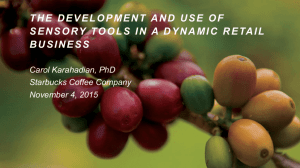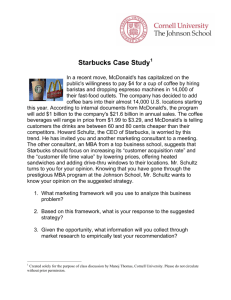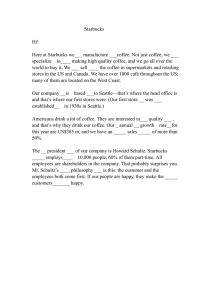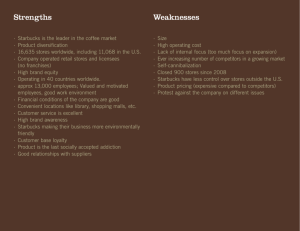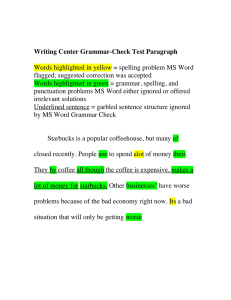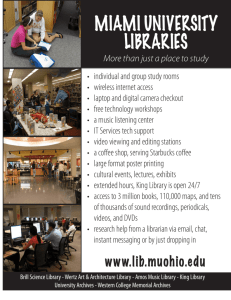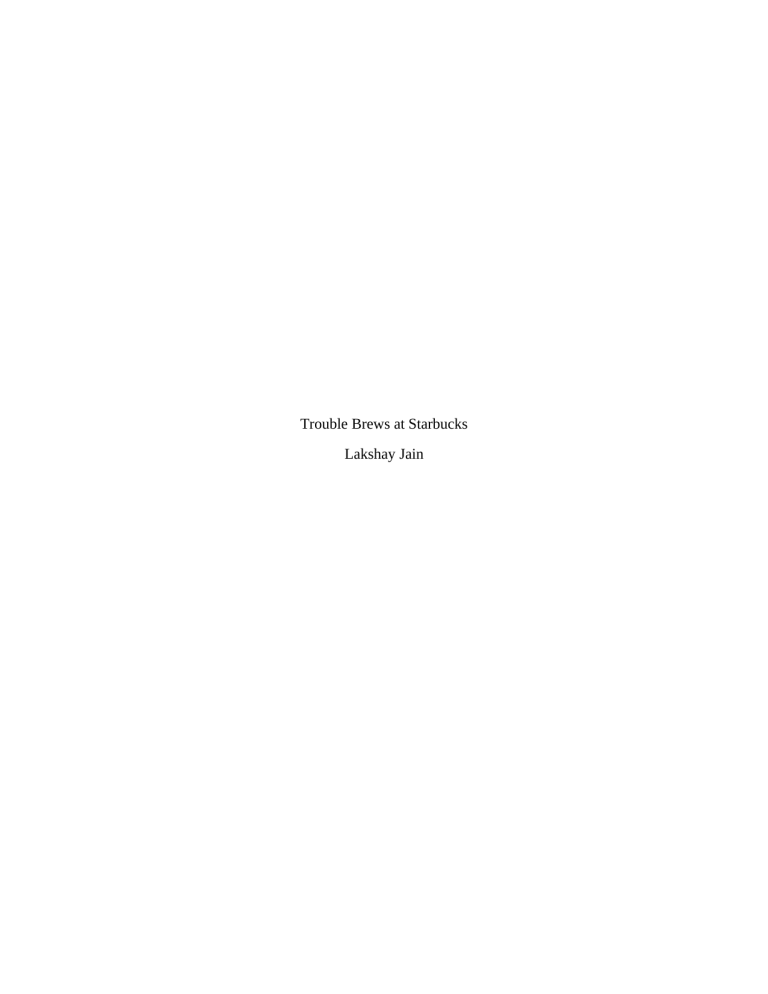
Trouble Brews at Starbucks Lakshay Jain Trouble Brews at Starbucks by Initial value proposition of Starbucks The vision of the original founders of Starbucks was to create a coffee experience that was different from the rest. The vision was one where the customers would get more enlightened about the intricacies of coffee as they consumed the beverage (Bussing-Burks, 2009, p. 5). Starbucks in the early years sold manual coffee pots and equipment for grinding and brewing coffee at home. The company shied away from selling electric coffee makers that interfered with the coffee’s flavor. When Howard Schultz acquired Starbucks, he made sure that customers got coffee of the best quality. The entity was to do this by controlling the product from the raw green coffee beans to when it reached the consumer’s cup (Buchanan & Simmons, 2009, pp. 2-4). Starbucks also insisted on the Italian coffee bar culture where people could gather, relax and interact amongst each other as they would do at home. Starbucks hired baristas who had the ability to engage customers to enrich the experience further. The baristas, therefore, had to be trained in coffee knowledge, customer service and basic retail skill (Buchanan & Simmons, 2009, pp. 2-4). Retaining the pool of well-trained baristas and the Starbucks value in the process, the company gave both the full time and part time staff medical cover. The brand Starbucks at the time was one that promised and delivered quality coffee and service to match. Customers willingly paid the premium price charged per cup for it. Strategies that Undermined the Initial Value Proposition Introduction of food: The Company decided to offer burgers, cookies, salads and Pastries throughout the day among other things (Buchanan & Simmons, 2009, p. 5). No longer would people sit around and talk over a cup of coffee as it was initially envisioned but they would also concentrate on eating as well. Some customers even went as far as complaining that the move had turned the stores from coffee houses to a restaurant such as McDonalds. The smell of food heated breakfast sandwiches for instance was irritating to the fundamental coffee lovers. Drive-through stores: The addition of Drive-through stores took away the idea of customers sitting and discussing issues as they engaged baristas (Enz, 2010, p. 3). Also, unlike in stores where customers with complex orders could step aside and let others be served it was not possible in a drive through (Buchanan & Simmons, 2009, pp. 6-7). As a result, customer waiting times increased significantly. Licensing: To get more exposure and additional revenue, Starbucks looked towards airports to obtain more clients. Since the company could not get a store in such locations, it had to license to Host Marriott’s for one. The effect of this was the loss of control of the quality of the coffee through the value-adding practices. Automation of the coffee making process to reduce customer waiting times: To reduce waiting times the company bought the company bought the Verismo 801 automated machine in the year 2000. This machine cut the time it took a barrister to make coffee by almost half (Schultz, 2012). However, due to the height of the machine the customer could not see and, therefore, could not interact with the barrister. The valuable experience of engaging in conversation with a barrister was lost. Introduction of Flavor lock sealed bags: By eliminating the need to grind, this bags did away with the authentic aroma of ground coffee that had been associated with Starbucks in a long time. It served to destroy the image of Starbucks as one that respected the ritual and process of making coffee. Cost reduction strategies: The stores were set up with fewer comfy chairs and less carpeting than before. Starbucks was no longer an inviting place to linger over a cup of coffee. Books, music and movies: Although the entertainment part of the business increased revenue, it was not part of the original value proposition. The customers were now distracted from engaging with each other (Buchanan & Simmons, 2009, pp. 7-8). How Going Public Affected the Original Value Proposition To satisfy Wall Street and its investors, Starbucks had to focus on continued growth. The company used a strategy of new products, a stronger connection with customers as the third base and expansions in the United States and around the world. The introduction of new products such as nonfat milk, even though it stopped lost sales to competitors, it did not go well with the coffee purists inside and outside the company. Frappuccino, which is not considered to be true coffee, and food items, were introduced as part of this new products strategy (Bussing-Burks, 2009, p. 28). Connection with the customer as a third place is what added music, books and movies to the new value proposition that came with the company going public. To expand as fast as Wall Street wanted the company had to license its brand and go into partnerships with other organizations. Such arrangements reduced some amount of control that Starbucks had on its outlets. Starbucks was also opened in countries that did not have a coffee culture and had to adapt its products to the local conditions which meant making changes to the processes and the final product. Howard Schultz’s Turnaround Strategies When Schultz came back as CEO of Starbucks, he announced the following agendas: Improving the state of the business in the U.S by returning the focus to the customer experience in the Starbucks stores. Coming up with new products, redesigning the stores and retraining the employees on how to ensure good customer experience; Reducing the pace of the stores being opened in the U.S and closing the underperforming ones in order to focus on the economics of the store-level unit; Going after the emotional attachment the customers had with the brand: Reorganizing Starbucks and streamlining management in a way that could support initiatives that focused on the client and allocating resources to key drivers of value; Increasing the rate of expansion and profitability of Starbucks in stores outside the country by diverting a part of the capital that had been earmarked to fund growth of U.S stores. Once Schultz got to work, notable actions were that he closed over 7,000 stores for 3.5 hours in order to retrain staff on making the perfect espresso even though the company lost $6 million in revenue that day as a result. The company had to go back to having staff that were knowledgeable in coffee and customer relations. This led to the laying off of 600 workers in 2000 (Enz, 2010, pp. 18-19). He brought in outside consultants to help in coming up with a detailed strategy. This is something he had never done in the past. The company invested in a national advertising campaign for the first time ever. The commercial was timed to air during the 2008 presidential elections and got around 70 million impressions. He decided to leverage the company on social media by hiring an expert who had worked at amazon who also improved the company website. Schultz realized that this was the best way to continue with the coffee conversation even after the consumer has left the premises and get ideas and feedback (Harvard Business Review, 2010) He instructed the baristas to return to the grinding of coffee inside the stores so that the coffee aroma that had been there once before could be sensed by the consumers. The company had old and outdated computers and coffee registered. They were replaced and an estimated 700,000 hours of waiting in lines is being saved (Schultz, 2012). The company closed around 600 stores in the country, in the processing saving about $ 850 million in costs (Enz, 2010, p. 19). This was a painful decision which went against the employee focused approach to business that Schultz developed. However, it had to be done. Schultz reorganized the supply chain and made it more efficient in delivering products to the stores and maintaining inventory levels. The number of correctly delivered orders improved from 3 out of 10 to 9 out of 10. Schultz also created a customer reward card to maintain customers at a time when losing them would be very costly. He continued offering health insurance to the customers as was always the case at a time when the economy was a low and the costs of doing this were high. This was to adhere to the original culture of valuing people that he had started for the company. Starbucks redesigned the company stores in order to make them more attractive for the customers to sit down once again and engage in conversation at the stores as they had done before. To encourage employee or partner performance, Starbucks announced that the partners would be rewarded based on performance. This reward was to come in form of salary increases. This further enforced the value Starbucks originally placed on people. To keep with his promise of coming up with new products Schultz decided to take a chance with instant coffee or VIA. It performed very well and even attracted a lot of media attention. The company also made commitments to double its fair-trade purchases so as to boost welfare of the farmers who an important are part of the coffee value chain. In a personal capacity, Howard Schultz studied the turnaround strategies of other leaders to get knowledge that he used to change the fortunes of Starbucks. As a result of these actions that were founded on the original value propositions, it took two years for the turnaround to start having results and revenues in 2010 had reached $ 10 billion. References Buchanan, L., & Simmons, C. J. (2009). Trouble brews at Starbucks. London: Richard Ivey School of Business, University of Ontario Bussing-Burks, M. (2009). Starbucks. ABC-CLIO. Enz, C. A. (2010). The Commoditization of Starbucks. Schultz, H. (2012). Onward: How Starbucks fought for its life without losing its soul. Rodale
